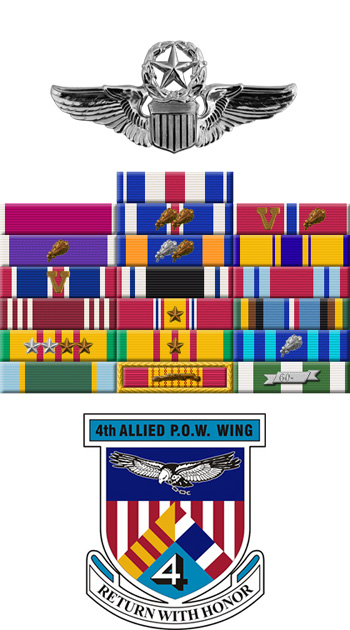
|
Roger D. Ingvalson |
 |
|||
| Rank, Service | ||||
Colonel O-6, U.S. Air Force |
||||
| Veteran of: | ||||
|
||||
| Tribute: | ||||
Roger Ingvalson was born on June 20, 1928, in Blooming Prairie, Minnesota. He enlisted in the U.S. Air Force on August 3, 1950, and after completing basic training he attended Airborne Electronics School before serving as an Airborne Radar Repairman at Randolph AFB, Texas. He was accepted into the Aviation Cadet Program of the U.S. Air Force in April 1952, and was commissioned a 2d Lt and awarded his pilot wings at Bryan AFB, Texas, on April 15, 1953. After completing F-80 Shooting Star and F-86 Sabre Combat Crew Training, Lt Ingvalson served as an F-94 Starfire pilot with the 437th Fighter Interceptor Squadron at Oxnard AFB, California, until November 1955, when he transferred to the 57th Fighter Interceptor Squadron at Keflavik, Iceland, flying F-89 Scorpions until November 1956. His next assignment was as an F-86 pilot with the 552nd Fighter-Bomber Squadron at Bunker Hill AFB, Indiana, from November 1956 to August 1957, followed by service as an F-100 Super Sabre pilot with the 406th Tactical Fighter Squadron at Turner AFB, Georgia, from August 1957 to January 1959. Capt Ingvalson next served as an F-105 Thunderchief pilot with the 433rd Tactical Fighter Squadron at Eglin AFB, Florida, from January 1959 to January 1962, and then Director of Flight Test Operations for the F-105 with the 4th Tactical Fighter Wing at Seymour Johnson AFB, North Carolina, from January 1962 to April 1965. Maj Ingvalson's next assignment was as an F-105 pilot with the 44th Tactical Fighter Squadron of the 18th Tactical Fighter Wing at Kadena AB, Okinawa, from April 1965 to January 1968, and during this time he deployed with this squadron flying combat missions in Southeast Asia from Korat Royal Thai AFB, Thailand, from April to June 1965, and in October 1965. Lt Col Ingvalson then served as an F-105 pilot and as Operations Officer for the 34th Tactical Fighter Squadron at Korat from January 1968 until he was forced to eject over North Vietnam and was taken as a Prisoner of War on May 28, 1968. After spending 1,752 days in captivity, Col Ingvalson was released during Operation Homecoming on March 14, 1973. He was briefly hospitalized to recover from his injuries, and then attended Air War College at Maxwell AFB, Alabama, before serving as an A-7 Corsair II pilot and Assistant Director of Operations for the 23rd Tactical Fighter Wing at England AFB, Louisiana. Col Ingvalson retired from the Air Force on September 1, 1976, and later started and directed a Prison Ministry in Tennessee for many years. Roger Ingvalson died on December 24, 2011, and was buried at the Chattanooga National Cemetery in Chattanooga, Tennessee. |
||||
|
||||

